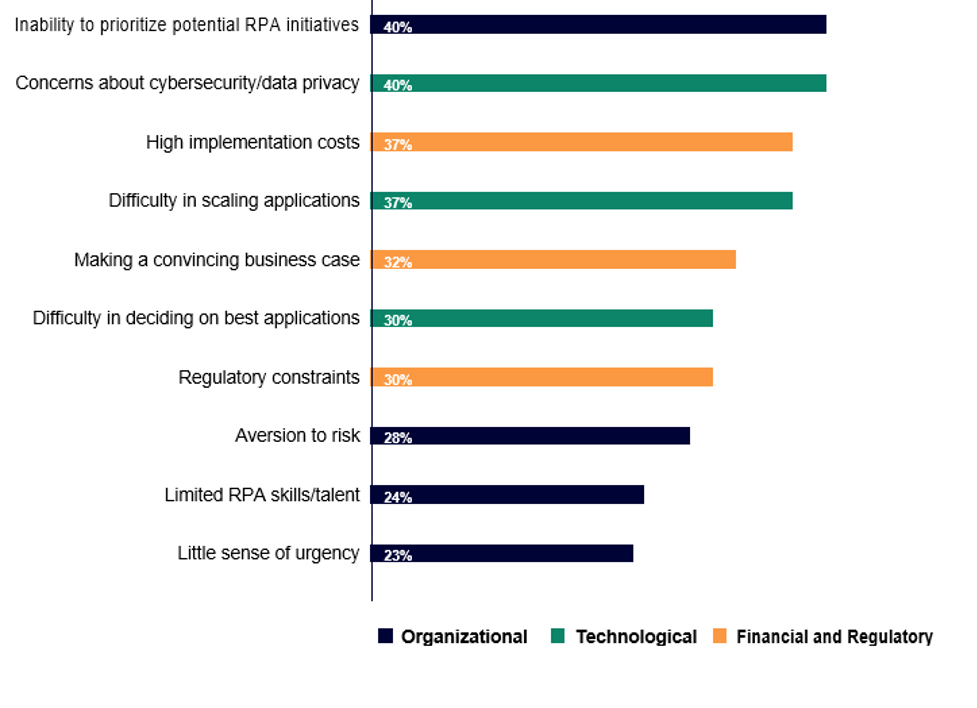What We Need to Know in the RPA Planning Process

Businesses need to create scalable RPA solutions that can be deployed across the organization and support the use of AI and other new technologies in the future.
Companies must ensure that processes are standardized, digitized and safe before they can be automated with robots.
RPA leaders use key functions and business units at all stages of RPA, from identifying opportunities to evaluating performance.
As the software for developing RPA tools has progressed to the point where user interfaces are intuitive and easy to use, individual departments using RPA often develop and deploy bots in local IT systems and even on desktops (i.e. robotic desktop automation). As a result, RPA often enters organizations under the radar with bots not tied to other systems and with little documentation on how they operate. To avoid such RPA efforts, companies need an effective RPA technology implementation plan that touches the right RPA practices, provides ongoing maintenance and lays the groundwork for supporting the future use of AI.
They also need a management structure with a clearly communicated operating model and instructions. The scattering approach that doesn't control and adapt to the organization's strategy is just one of many challenges companies face in adopting RPA entrepreneurship. For example, our results show that 40% of organizations are concerned about the cybersecurity of their RPA implementations. It is almost struggling to scale RPA applications in their organizations. Almost one in three companies has trouble choosing the right applications for the tasks at hand. Insufficient data availability and insufficient IT infrastructure contribute to the problems that may arise.
Biggest Factors for Not Accepting RPA

To help companies develop RPA implementation plans, our research highlights the lessons learned by those most advanced in RPA use:
• Start with processes that are easy to automate with RPA.
All attention will be on early efforts, so organizations should start directly and with processes where RPA is likely to add significant value.
• Make processes as efficient as possible before automating.
Many organizations will automate a process as it is. But getting the most out of RPA is all about process optimization and transformation. A manual process full of inefficiencies will become an inefficient automated process, ignoring much of the potential gain. Companies should also look at the processes they have already automated and make sure they are fully optimized.
• Make sure you use the right tools for the processes in your organization.
The processes can be very complex that business leaders cannot achieve at the outset of RPA implementation. Automating the entire process may require more than RPA. For example, optical character recognition (OCR) or natural language processing software may be required to handle all variability in a process. Blue Prism from Marchuk, said the issues at the corporate level is different than an individual department. Scalability and security needs will be more stringent at the enterprise level and should be considered if individual units are operating on their own.
Another example: Some companies will try to take advantage of RPA if an ETL tool can be more efficient in data conversion and loading.
• Consider the scalability of the application and whether it can support advanced AI technologies.
Companies often don't know how many bots are located, how they work, or where they are used. Once the adoption of RPA begins at a local business or functional level, as is usually the case, applications cannot be used by others. As a result, organizations often struggle to scale these RPA applications and manage them on a single platform. In addition, bots will eventually be powered by new technologies including AI. Organizations need to be ready to improve their use of technology.
• Evaluate and prevent all cybersecurity and data privacy risks associated with the planned RPA implementation.
Businesses that do not centralize RPA development and monitoring put themselves at greater risk with their customers and suppliers. To ensure the safety of the bots, the initial development of each application and the changes to be made should be documented. Every application should have an audit trail that shows how and by whom, what they did and who made changes.
• Make sure you buy the correct RPA software.
Companies should be careful with the number of bots they buy or license. Businesses usually earn more. Given the timeline of the processes and the resources required to develop and maintain them, bots are more than they can use. Companies often make hasty decisions assuming that all RPA software does the same thing. In practice, different platforms take very different approaches to automate processes and behave differently with the technologies they interact with. Questions to consider include: Is Citrix or remote desktop required for interaction with the base system? Which ERP system is used? API ' Can s be used or is surface automation required? Will all automation be unattended or will certain processes require manual interaction?
• Plan and budget for ongoing care.
A comprehensive audit trail for each bot can play an important role in maintenance. RPA implementations often mimic a large number of computer processes. Even a very small change such as renaming a database field can cause the application to malfunction. Understanding how the bot works can speed up the process of understanding what went wrong. Many companies underestimate the need for functional and technical resources required to support an RPA environment, especially with regard to managing exceptions and changes. However, this is a very important issue that needs attention.
• Analyze and monitor the cost effectiveness of each RPA implementation.
Beyond efficiency and cost savings, it's important to monitor the full value RPA provides. Businesses must monitor improvements in efficiency, quality and speed. They should also evaluate developments in employee engagement and customer satisfaction.
"Those who cooperate with Robotic Process Automation and artificial intelligence will be successful people and institutions of the future…."
As PRP Business Solutions, we develop RPA solutions and manage your processes. You can reach our services by clicking here .